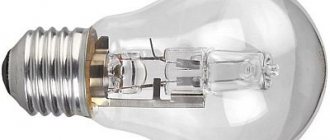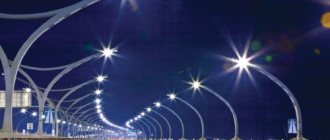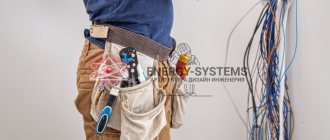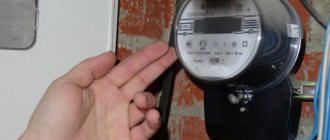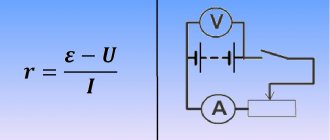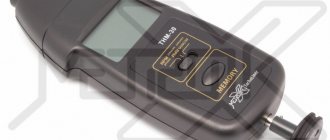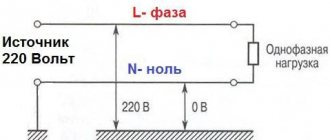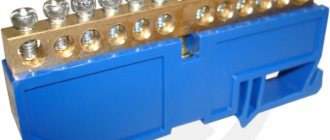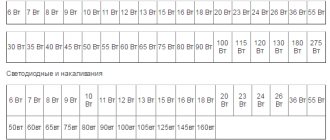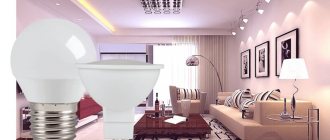Comfort and coziness, pleasant light that does not irritate the eyes, but at the same time a sufficient amount of electric lighting are necessary conditions for ensuring the comfort of modern human housing. Therefore, when choosing light bulbs, first of all you need to consider where and for what it will be used, which should correspond to the power of the lamp and its light range. For example, in the office and bathroom you need bright white light, and in the bedroom or under - muted warm light. There are currently two new types of light bulbs on sale: energy-saving and LED. Let's figure out which light bulbs are best to use for your home .
The advantage of LED lamps over incandescent lamps is due to the production of luminous flux not due to the glow of a hot filament, but through the use of luminescence (energy-saving products) or the glow of a pn junction (LED). These lamps have similar dimensions and are convenient to use, since standard lamp sockets for lighting devices are used to connect them, Figure 1.
LED lamps with different types of base
Which light bulbs are better? You will find the answer to this question after a comparative analysis of two competing types of lamps. When the consumer is faced with the question of what to choose, the most correct decision would be to get acquainted with the existing types of light bulbs, with their technical characteristics and features.
This article is for those who want to install a switch with two keys.
Incandescent lamps
“Ilyich’s lamp” is the very first type of electric lamp. The lamp consists of a glass bulb containing a tungsten filament. An electric current passes through the filament, heating it to a temperature that creates light. Such lamps are used, as a rule, in household and decorative lighting, as well as where there are no special requirements for lighting, and the consumption and service life of the lamps are not determining factors.
The advantage of such light bulbs is their low cost. That's probably all. Incandescent lamps cannot provide high quality color rendering, but they can bring an atmosphere of comfort and warmth to your home. They are absolutely not suitable for lighting shop windows and retail spaces in stores where it is important for the buyer to see the exact color of the product.
Incandescent lamps have high energy consumption. There are models of incandescent lamps with different types of coating, which are more economical. When designing the interior, you should take into account the high heat transfer of these lamps and use them at a safe distance from fusible (PVC stretch ceilings, polyurethane decorative elements) and fire hazardous materials.
Why do energy-saving lamps burn out quickly?
The service life of fluorescent lamps is influenced by operating factors, as well as power fluctuations in the network. They cannot be turned on and off frequently. If you know this and avoid improper operating conditions, then such light bulbs will last longer.
Also, energy-saving lamps should not be touched with your hands, because you will simply leave grease on their surface. And this, in turn, will lead to burnout. If you accidentally touch the surface of such a lamp, its surface must be wiped with a fiber-free cloth soaked in alcohol.
Why it is better to use energy-saving lamps and which ones are better to choose, read about it here.
The main harm of energy-saving lamps is the mercury content. If you accidentally break a lamp, carefully collect everything, do a wet cleaning with a solution of potassium permanganate and ventilate the room well. Burnt-out lamps cannot simply be thrown into the trash; they are subject to mandatory disposal by specialized enterprises.
Halogen lamps
Halogen lamps are an improvement on incandescent lamps. The advantage of halogen lamps is their consistently bright light, excellent color reproduction and the ability to create a variety of light shades.
They are known for moderately high efficiency, light quality, and high wattage ratings compared to conventional incandescent bulbs.
How do they work?
A halogen lamp functions exactly the same as an incandescent lamp, with one notable exception: the halogen cycle. In a conventional incandescent lamp, tungsten slowly evaporates from the burning filament. This causes the lamp to turn black, which reduces light output and shortens lamp life.
Halogen lamps can largely eliminate this problem because the halogen gas chemically reacts with the evaporated tungsten to prevent it from sticking to the glass. The remaining tungsten is returned to the filament, which also increases the life of the lamp. Because the temperature required for this reaction is higher than that of a conventional incandescent lamp, halogen lamps are made using quartz.
Halogen lamps are used in a variety of applications, both commercial and residential. They are used in car headlights, lighting for sofa corners, cabinets, and table lamps.
Rating of LED lamps for the home
In Russia, the market for LED lighting equipment is not large and is still just being formed.
Therefore, the share of domestic LED products on the market is small; mainly imported LED lamps are sold. Almost all the manufacturers listed below have official websites in Russian.
European countries
It is believed that LED products made in Europe are of high quality, harmless to health, and meet all modern requirements for lighting devices. Of course, this also affects the price. Philips . A global brand based in the Netherlands, working for people in three main areas: healthcare, lighting solutions and consumer products.
LED lamps from this manufacturer can cost 500–1800 rubles. They can be purchased in almost any specialized store or retail outlet where there is a department of electrical lighting devices. Osram . A German company, known throughout the world for more than 100 years as a supporter of “intelligent light.” Lamps can be purchased at a price of 400–1600 rubles also in specialized lighting stores.
Foton Lighting . Manufacturing and trading lighting engineering company with head office in London. Foton Lighting LED lamps cost 400–700 rubles. They are easy to find in online electrical stores.
Japan
Japanese engineers have a reputation as pioneers in many fields of technology. And Japanese attention to detail competes with German and will not leave the buyer indifferent. This is why the products of the Land of the Rising Sun are so popular all over the world. And LED lamps are no exception. Nichia . High-brightness LEDs produced by this company have long been used in dozens of areas of modern industry, and recently they have found their consumer in everyday life.
Nichia LED lamps is the use of special optical lenses, which reproduces a uniform distribution of light, thereby creating the effect of natural lighting. Prices for lamps from this manufacturer start at 300 rubles.
Russia
Domestic LED products are currently of sufficient quality and are not inferior to European ones, but with the same characteristics they may cost less due to the fact that they are produced Additional capacities are located on the territory of Russia. Gauss . A wide range of LED products that undergo strict quality control in independent laboratories in Europe, China and Russia. LED lamps cost 400–2000 rubles, they can be purchased at the Gauss brand store and other household appliances outlets.
"Optogan" . Optogan group of companies is one of the few in the world and the only one in Russia that has technologies and a full production cycle of LEDs and LED equipment. In Russian retail chains, Optogan LED lamps for household lighting have been introduced since 2011. The model range is updated from time to time. The average cost of "Optogan" is 500–700 rubles, which is cheaper than Western manufacturers.
As of today, the company sells over 1,000,000 LED lamps per month. The quality of the products has received awards at international exhibitions, and prices start from 100 rubles. You can purchase LED lamps from this company in online stores, supermarkets, construction markets, and lighting equipment stores.
China
Here, first of all, it is worth warning the buyer that the practice of buying nameless LED lamps in Chinese online stores is currently not justified, because no one is responsible for the quality itself, nor for the possible consequences. You should not recommend lamps of dubious manufacture. For example, 0.15 W and 0.09 W LEDs can be produced in the same packages as 0.5 W and supplied in the same quantity. Only the lamp will give, for example, 400 lm instead of 1700 lm.
However, in Russia you can buy certified products from well-known Chinese brands, the quality of which is beyond doubt. Camelion . Very high quality lamps, lighting equipment, power supplies and flashlights, which have been produced for more than twenty years. The company's Russian-language website provides complete information about the products, including certificates of conformity.
The warranty on LED lamps is 3 years from the date of purchase, service life 30,000–40,000 hours. You can purchase them at various points: large Russian retail chains, online stores and specialized lighting stores. Cost 100–450 rubles. Selecta . The range includes light sources, lamps and accessories for them. The products are available in a wide format in online stores of lighting equipment.
For your home, it would be nice to use ultra-thin recessed LED lamps costing about 700 rubles, as well as various ceiling LED lamps costing 1200–1300 rubles. Estares. Top brand of the famous Chinese company MaySun. It is also intended for general use. You can purchase LED lamps, LED controllable lamps for your home, office and retail space in stores that sell lighting equipment and LED products.
Russia-China
A distinctive feature of the products is the combination of innovative technologies with reliability and ease of use. Ecola . LED lamps GX53 produced by Ecola are energy-saving, flat, used for stretch and suspended ceilings in offices and at home. Cost 150–500 rubles. You can purchase them both on the company’s website and at multi-brand online and offline retail outlets.
Newera. The brand of the company SVeto-Led, under this brand LED lamps have been produced at Chinese production facilities for 9 years. You can buy them through the website of the SVeto-Led company at a price of 170–500 rubles.
Fluorescent lamps
Fluorescent lamps, also called fluorescent lamps, are divided according to light parameters into lamps with the highest possible luminous flux and into lamps with a lower luminous flux, but increased color rendering quality. Such lamps can emit different colors, which is widely used in lighting offices, store windows and exhibition halls.
Advantages of fluorescent lamps:
- wide color range;
- compared to incandescent lamps, it provides the same luminous flux, but consumes 4-5 times less energy;
- have a low flask temperature;
- increased service life;
Disadvantages of fluorescent lamps
:
- reduces luminous flux at elevated temperatures;
- because they contain mercury, many fluorescent lamps are classified as hazardous waste;
- fluorescent lamps are not suitable for operation at air temperatures below 15-20 °C.
- They may flicker, which negatively affects the work process and your own nerves.
Energy saving lamps
Energy-saving lamps produce light according to the same principle as conventional fluorescent lamps, only over a much smaller area. Their design feature is the presence of an electronic unit that ensures ignition and further burning of the lamp. Thanks to it, the energy-saving lamp lights up without flickering and works without blinking, which is typical of conventional fluorescent lamps.
Energy-saving lamps can have different color temperatures, which determine the color of the lamp: warm color, daylight (white) color and cool white color, and accordingly their scope is wider.
- The amount of electricity consumption of these lamps is reduced by 80%;
- The service life is 6-15 times longer compared to conventional incandescent lamps and is, accordingly, 6000-15,000 hours depending on the type;
- Less maintenance losses due to long service life
- Possibility to choose the color of the glow.
The disadvantages include their high cost, but their long service life and low energy consumption compensate for this disadvantage.
The toxic contents of energy-saving lamps require very careful handling. Such lamps cannot simply be thrown into the general trash, they must be handed over to special collection points, and if the lamp breaks at home, then it is necessary to treat the contaminated area in the same way as if you broke a mercury thermometer.
Energy-saving light bulbs (which light bulbs are better)
Energy-saving fluorescent lamps are in very high demand among consumers on the market. Unlike an incandescent lamp, where light is transformed by passing electrical energy through a tungsten filament, light in an energy-saving lamp is converted from ultraviolet radiation o the glow of a gas discharge, which is formed by the passage of an electric discharge through the gas filling the flask. Their advantages include light output, economical energy consumption, they heat up less and have a long service life. Quite often, consumers complain that lamps burn out much faster than the service life declared by the manufacturer.
Energy-saving lamps
LED bulbs
According to most experts, the future of lighting lies in LED lamps and luminaires. The devices use LEDs as a light source, which emit light when current passes through semiconductor crystals.
- LEDs are 4-7 times more efficient than conventional incandescent or halogen equivalents.
- LEDs have a lifespan of 15,000 to 50,000 hours.
- LEDs illuminate 5-10 times more area than halogen lamps.
- LEDs are more expensive to buy, but cheaper overall when considering lifetime energy use costs.
LED bulbs can be used for landscape lighting, interior lighting, and can be mounted in paving stones, asphalt or a wall. This is an ideal tool for marking and illuminating paths, car parks and places where replacing lamps is quite labor-intensive, for example, in aquariums and swimming pools.
One lamp equipped with a 60-watt incandescent lamp consumes about 525 kWh of electricity per year. Install an LED lamp in this luminaire and annual energy consumption will be reduced to 65 kWh.
Thus, after comparing all the pros and cons of light bulbs, choose the most suitable one for your needs.
